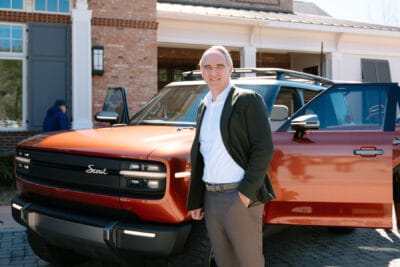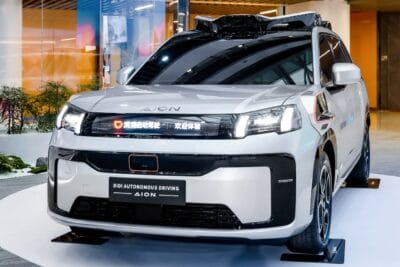Tesla releases 2024 financial results: Revenue is up, but profits are down
Tesla posted a total revenue of $97.7 billion for the whole of 2024, which is a one per cent increase compared to the previous year. YoY growth was thus definitely lower than in the previous years. In 2023, the EV maker posted a turnover of 96.8 billion dollars – a 19 per cent increase compared to 2022. Nevertheless, revenues are up.
However, that cannot be said for all segments. Total automotive revenues came to about 77.1 billion dollars last year – that is 6 per cent less than in 2023, when Tesla’s flagship business earned the company just over 82 billion dollars. Only thanks to the energy division, with sales of $10.1 billion (+67 per cent) and service/other sales ($10.5 billion, +27 per cent), was Tesla able to achieve company-wide sales growth of just one per cent to 97.7 billion dollars.
This is the first time since 2020 that Tesla has posted a lower figure for its cars than the previous year – at least when it comes to revenues. Looking at profits, this is the second year in a row the carmaker has not surpassed the previous year. In 2024, Tesla made 17.45 billion dollars in profit, compared to 17.7 billion dollars in 2023 and 20.85 in 2022. The reason is the shrinking profit margin caused by price wars in China, for example. In 2023, the operating margin was 9.2 per cent (already a significant drop from the 16.8% in 2022), while it was only 7.2 per cent in 2024.
2024 was a difficult year for Tesla
The manufacturer posted its production and delivery figures for 2024 a few weeks ago. Despite a strong fourth quarter, Tesla missed the record from 2023, delivering 1.79 electric vehicles in 2024. Production also declined: while Tesla reported 1,845,985 vehicles produced in 2023, the figure for 2024 is only 1,773,443 units, a difference of around 72,500 vehicles or 3.9 per cent.
There were a few factors at the beginning of the year that affected these figures in a negative way: In Q1/2024, a conflict on the Red Sea, which led to ship diversions and thus a lack of parts in the factories, and the arson attack on the Gigafactory Berlin had a major impact on production.
Let’s look at Q4/2024, when Tesla set a record for deliveries with 495,570 vehicles. However, that was apparently only possible with discounts: Revenue from the car business fell by 8% YoY, with Q4 2023 being Tesla’s best quarter to date (484,507 deliveries). In fact, the $19.8 billion in automotive sales is only the third-best figure of the year: In Q2, Tesla generated $19.88 billion in car sales, in Q3 even $20.02 billion – with fewer vehicles in each case. In the fourth quarter, the energy business in particular, with growth of 113 per cent to 3.1 billion dollars, also ensured that total turnover in the final quarter increased by two per cent to 25.7 billion dollars. On a positive note, Tesla has shed its former volatility – four of the five previous quarters were around 25 billion dollars. However, analysts had expected an average quarterly turnover of 27.2 billion dollars.
A look at sales alone shows that 2024 was not an easy year for Tesla: the company has long since had to abandon its goal of selling 50 per cent more cars every year in the medium term – and in 2024, sales fell slightly for the first time in the company’s history. Although 1.79 million electric cars delivered were still very close to the unofficial title of the world’s largest electric car manufacturer, the momentum is in favour of runner-up BYD. With enormous growth, the Chinese have come within a few thousand electric cars of Tesla. If you include plug-in hybrids, BYD is already far ahead.
Nevertheless, Tesla expects the Model Y to be the world’s best-selling car across all drive types – for the second time in a row. “In 2024, Model Y was the best-selling vehicle of any type in Denmark, Norway, Sweden, Switzerland and the Netherlands and we expect Model Y to have been the second best-selling vehicle of any type in Europe,” the carmaker states.
Production costs per vehicle fall to 35,000 dollars
“In 2024, we made significant investments in infrastructure that will spur the next wave of growth for the company, including vehicle manufacturing capabilities for new models, AI training compute and energy storage manufacturing capacity, Tesla states. “Affordability remains top of mind for customers, and we continue to review every aspect of our cost of goods sold (COGS) per vehicle5 to help alleviate this concern. In Q4, COGS per vehicle reached its lowest level ever at <$35,000, driven largely by raw material cost improvement, helping us to partially offset our investment in compelling financing and lease options.”
Two points are important here: One is the manufacturing capacity that Tesla addresses. That is because the more affordable models announced around a year ago are due to go into production in the first half of the year. “Plans for new vehicles, including more affordable models, remain on track for start of production in the first half of 2025,” writes Tesla, adding that “these vehicles will utilize aspects of the next generation platform as well as aspects of our current platforms and will be produced on the same manufacturing lines as our current vehicle line-up.”
Production revolution then in 2026?
The long-awaited ‘unboxed’ manufacturing strategy will only come with the Cybercab – with series production planned for 2026. The models due to debut this year will thus be built conventionally.
According to Tesla, this will lead to lower cost reductions than expected, “but enables us to prudently grow our vehicle volumes in a more capex efficient manner during uncertain times.” The company intends to “fully utilise” its existing production capacity of almost three million vehicles before investing in new production lines. Specifically, production is set to grow by 60 per cent by 2024. Measured against the 1.77 million units from the previous year, this would be just under 2.84 million cars – and a return to the growth path.
However, Tesla is otherwise keeping a low profile on the new models for 2025. Even in the usual list of individual plant capacities, the company does not reveal where the vehicles will be built. The largest Tesla plant is still Giga Shanghai with a capacity of over 950,000 vehicles, followed by Fremont (100,000 Model S/X and more than 550,000 Model 3/Y, and Giga Berlin with over 375,000 Model Y. The latter is on par with Giga Texas – where the production capacity is split between 250,000 Model Y and 125,000 Cybertruck.
Preparations for a third model are underway at Giga Texas, where unboxed manufacturing of the Cybercab is scheduled to start in 2026. Next year, the company will scale up production of the electric truck Semi in Nevada. The company’s truck factory is scheduled to start production at the end of this year, with work on the roof and walls recently completed.
However, the large site in Texas is not only relevant for Tesla’s production. In the fourth quarter, the company completed the construction of Cortex there, a training cluster for artificial intelligence. “Cortex helped enable V13 of FSD (Supervised)1, which boasts major improvements in safety and comfort thanks to 4.2x increase in data, higher resolution video inputs, 2x reduction in photon-to-control latency and redesigned controller,” says Tesla. Overall, the company has expanded its AI training by 400 per cent over the past year.
FSD (Supervised) to come to Europe
And this is precisely the second important point, where Tesla even speaks of a “seminal year in Tesla’s history.” Full Self Driving (FSD) will continue to be rapidly improved with the aim of surpassing human safety levels. “This will eventually unlock an unsupervised FSD option for our customers and the Robotaxi business, which we expect to begin launching later this year in parts of the U.S. We also continue to work on launching FSD (Supervised) in Europe and China in 2025.”
This was not just a statement made by Elon Musk in the heat of the moment, but a well-considered formulation on the overview page of the earnings report.
However, the work on the unsupervised FSD systems is not yet generating any revenue, and the investments in AI are only having a short-term impact on the balance sheet in one area: ‘Operating expenses’ have risen further by 18 per cent, from 8.77 to 10.37 billion dollars. In 2020, Tesla still managed with 4.6 billion dollars.
At least one former problem child is no longer eating up money, on the contrary: with 31.4 GWh of installed storage capacity (of which 11.0 GWh alone in Q4), the energy business has generated profits, as costs in the US factory have also fallen at the same time. Construction of the megafactory for stationary storage systems in Shanghai has been completed and production is set to be ramped up in the current quarter. The signs in this division therefore continue to point to growth.
Tesla now also processes lithium
This also applies to the Superchargers, which will also become a greater source of income when they are opened up to third-party brands. At the end of 2024, there were 6,975 Supercharger locations worldwide with 65,495 charging points – 17 or 19 per cent more than at the end of 2023. 5.2 TWh of energy was supplied at these charging points last year. And with the new V4 control cabinet, the course is being set for the future with 800-volt vehicles. Up to 500 kW charging power will be possible for cars, and even 1.2 megawatts for the Semi electric truck.
Incidentally, Tesla mentions almost in passing on page ten of the report that it has processed its first spodumene in its own lithium refinery. This happened just 18 months after the start of construction – “much faster than any plant we know
of outside of Asia.” The intermediate product produced there has met expectations and the factory in Corpus Christi will go into operation in 2025.
However, it will probably be some time before the company’s own lithium develops into a real competitive advantage. So far, the 4680 cells produced by Tesla itself have only been used in the Cybertruck – where Tesla can produce cells for 2,500 vehicles per week. In the models, however, the e-pickup is only listed under ‘Other.’ The Model 3 and Model Y are responsible for the large volumes – and later this year possibly the cheaper models.
Despite the new models, Tesla does not want to give an exact growth forecast. “With the advancements in vehicle autonomy and the introduction of new products, we expect the vehicle business to return to growth in
2025,” the annual report states. “The rate of growth will depend on a variety of factors, including the rate of acceleration of our autonomy efforts, production ramp at our factories and the broader macroeconomic environment.” On another point, however, Tesla does get specific: We expect energy storage deployments to grow at least 50% year-over-year in 2025.”





1 Comment